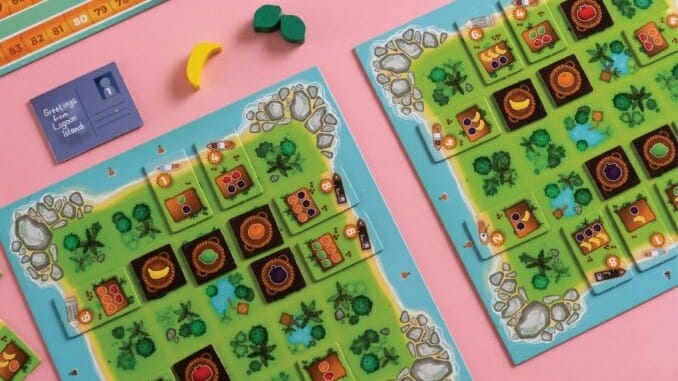Juicy Fruits is the first game in Capstone’s new line of family titles, and while it has nothing to do with a certain (disgusting, grey) chewing gum of a similar title, I do think this game is gonna move ya.
In Juicy Fruits, two to four players will each slide tokens around their personal island boards to collect fruits—limes, bananas, pomegranates, oranges, and mangosteens—that they can then use to clear ships off the four sides of their boards, buy building upgrades for points, or convert to ice cream for more points. The game moves very quickly, and ends when a certain number of “licenses” have been issued for buildings or ice cream stands, which can happen very quickly if you’re not careful and can even form a strategy for a player who doesn’t feel quite as ambitious (similar to the strategy in Thurn und Taxis to end the game as quickly as possible by building all your houses/a seven-station route).
The core mechanic here is the slider move, very popular in puzzle games going back to the 1982 classic Sokoban. Here, though, you use it to gain resources, rather than to solve a puzzle. Each player starts with five square tiles, showing one of each fruit, placed on the open 3×3 grid at the centers of their island boards. Move a lime tile one space in any direction and you get one lime. Move it three spaces, which is impossible at the start of the game, and you get three limes. And so on.
Once per turn, you may trade in fruits you’ve collected for ships, buildings, or ice cream. (Why would anyone choose something other than ice cream? I find this unrealistic.) Ships can cost anywhere from 2 fruit tokens to 6, and they occupy the 12 spaces on the sides of your 5×5 island grid, not counting the four corners. When you clear one, you get 1 to 8 victory points, and you get more room to slide your tokens around for resources. Buildings come in three main types. You can get better tokens to use on your board, such as tokens that show two different fruits and allow you to collect them in combination (e.g., slide the lime/mangosteen token three spaces and take three total fruits in any combination you’d like). You can get an ice cream token, which lets you build ice cream stands for lots of points. Or you can get a building that gives you points at game end—but that becomes a permanent stall on your island, blocking your sliding activities. The most valuable building is worth 18 points, but takes up a 2×2 space, or 16% of your whole island if you’ve already cleared all of your ships.
The ice cream does seem to be the best way to go. An ice cream token lets you exchange sets of fruit tokens for specific ice cream tiles on the main board, which can be worth 7 to 16 points (the last requires one token of each of the five fruits). You may exchange tokens multiple times if you slid your ice cream token more than one space on your board. You can also exchange two fruits of the same type for a 3-point milkshake, which, well, there’s no yard here so let’s just let that one slide. Each time a player builds any building, it drops the license tracker one spot towards zero, and the same happens when any pile of ice cream tiles is exhausted. That’s seven licenses for a two-player game, more for more players, but it ensures things move very quickly.
The game also comes with a built-in juice factory expansion where you can move another token on a separate progress board, which adds a layer of complexity that might satisfy certain players but I think detracts from the sheer elegance of the core game—and the accessibility it offers some younger players. I’d set the lower end of the range for this game at around age 7, although the great fruit tokens themselves will probably get your younger kids asking to play—and you can do so by ignoring the points and just showing them how to get fruit and collect them as sets. Games take maybe 30-40 minutes at the most with quick setup and cleanup. There’s also a solo mode here I haven’t tried because my daughter will absolutely ask to play if I take the game out. It’s a lot of fun and very inclusive of new or younger players.
Capstone also recently released the game CloudAge, which I have also reviewed for Paste.
Keith Law is the author of The Inside Game and Smart Baseball and a senior baseball writer for The Athletic. You can find his personal blog the dish, covering games, literature, and more, at meadowparty.com/blog.
